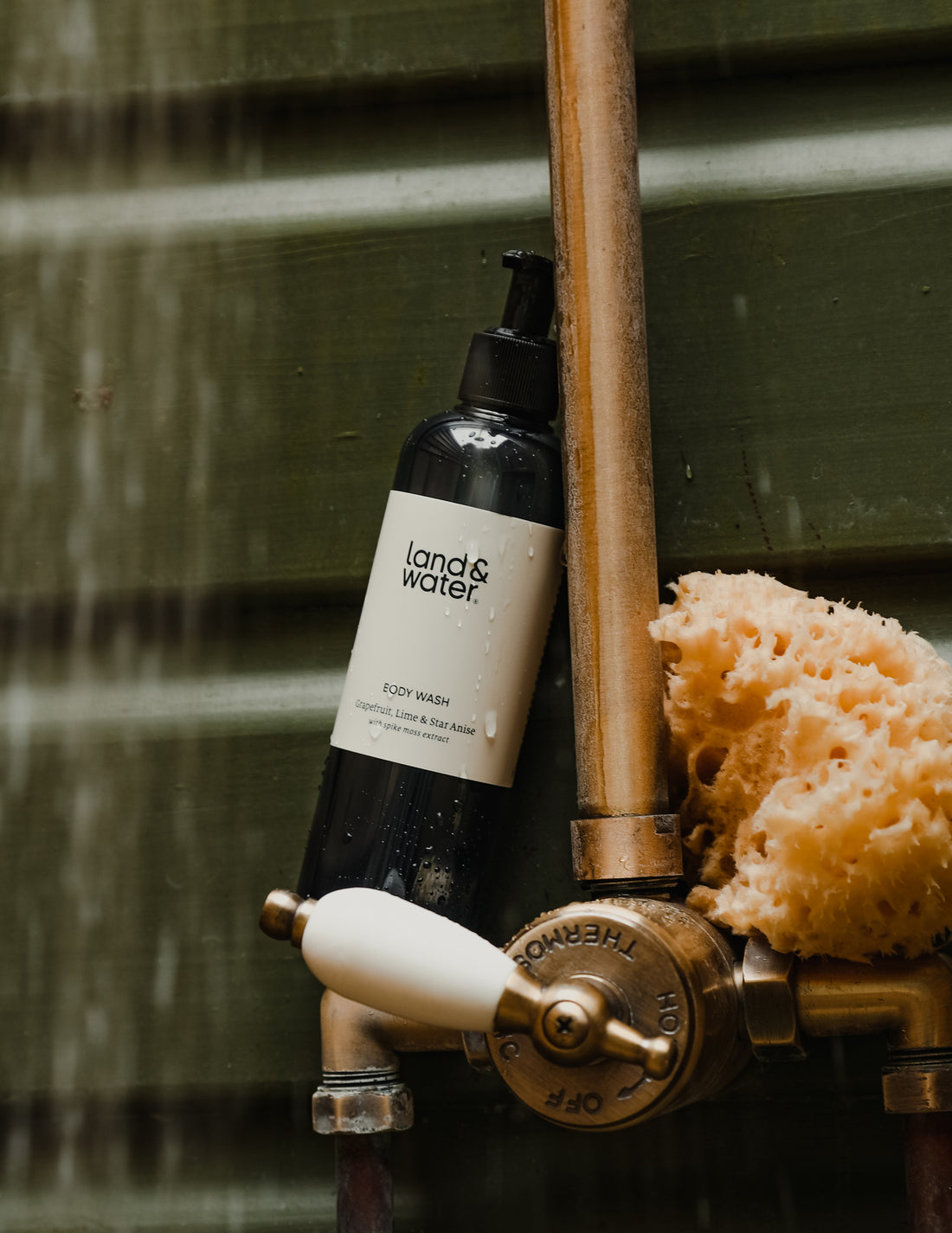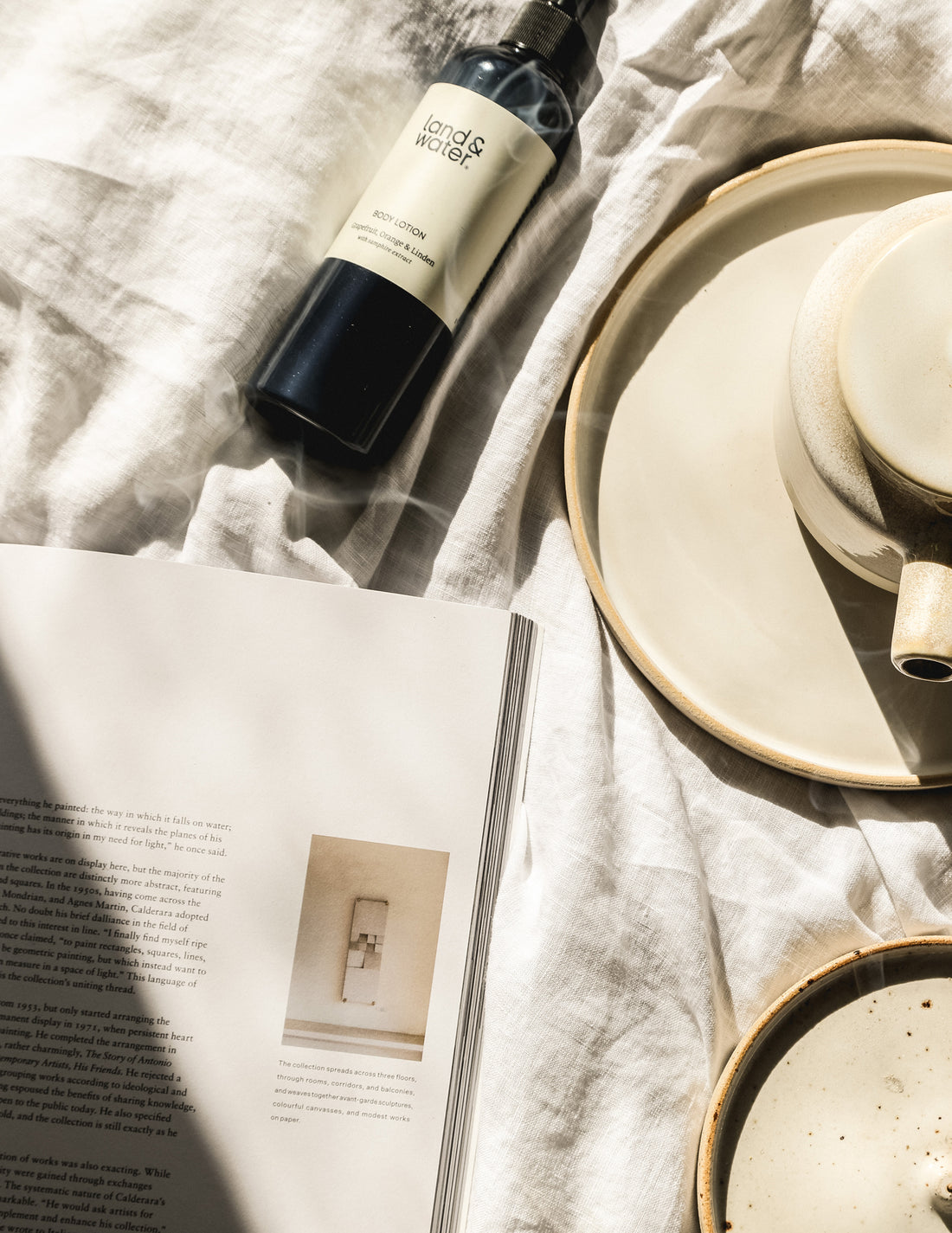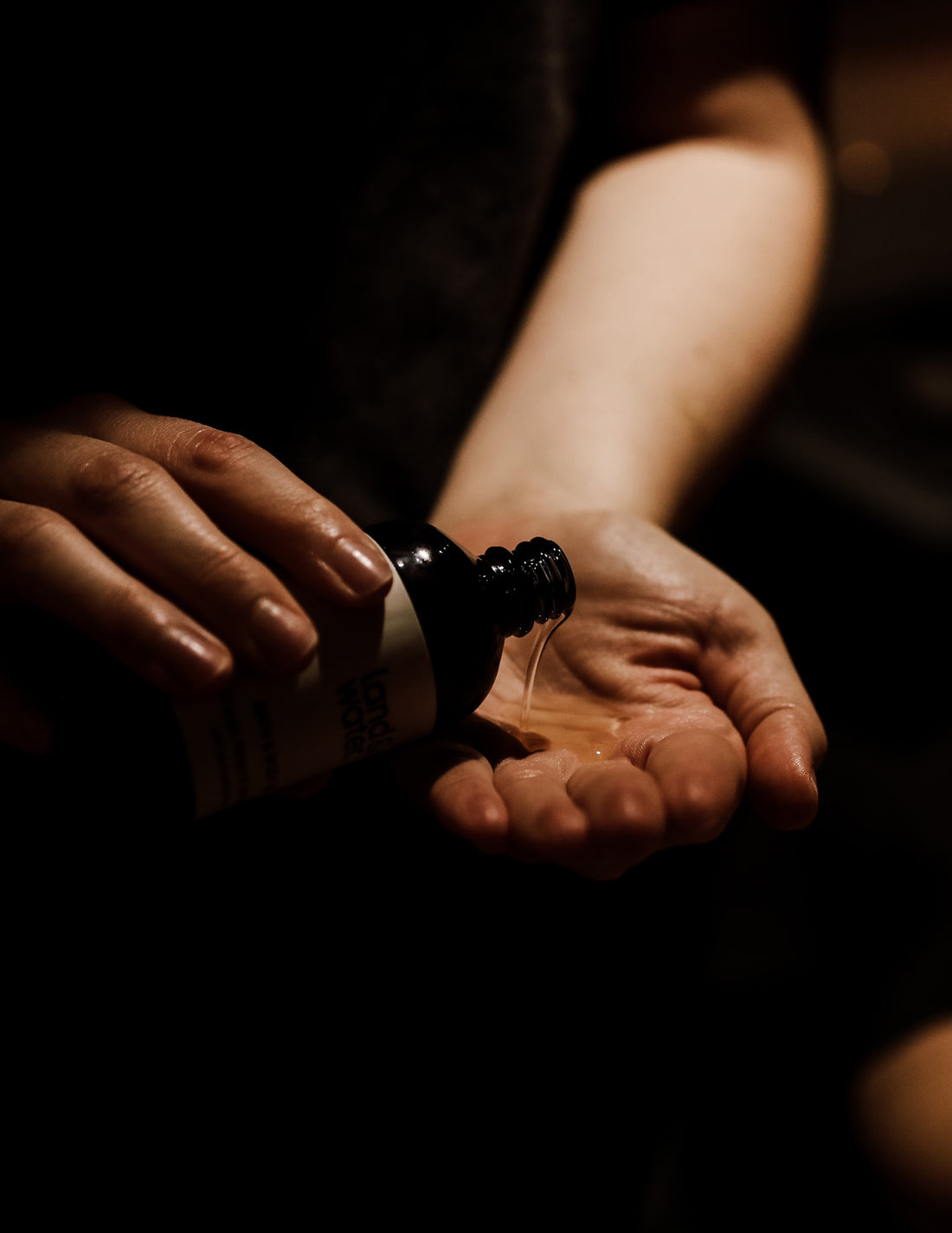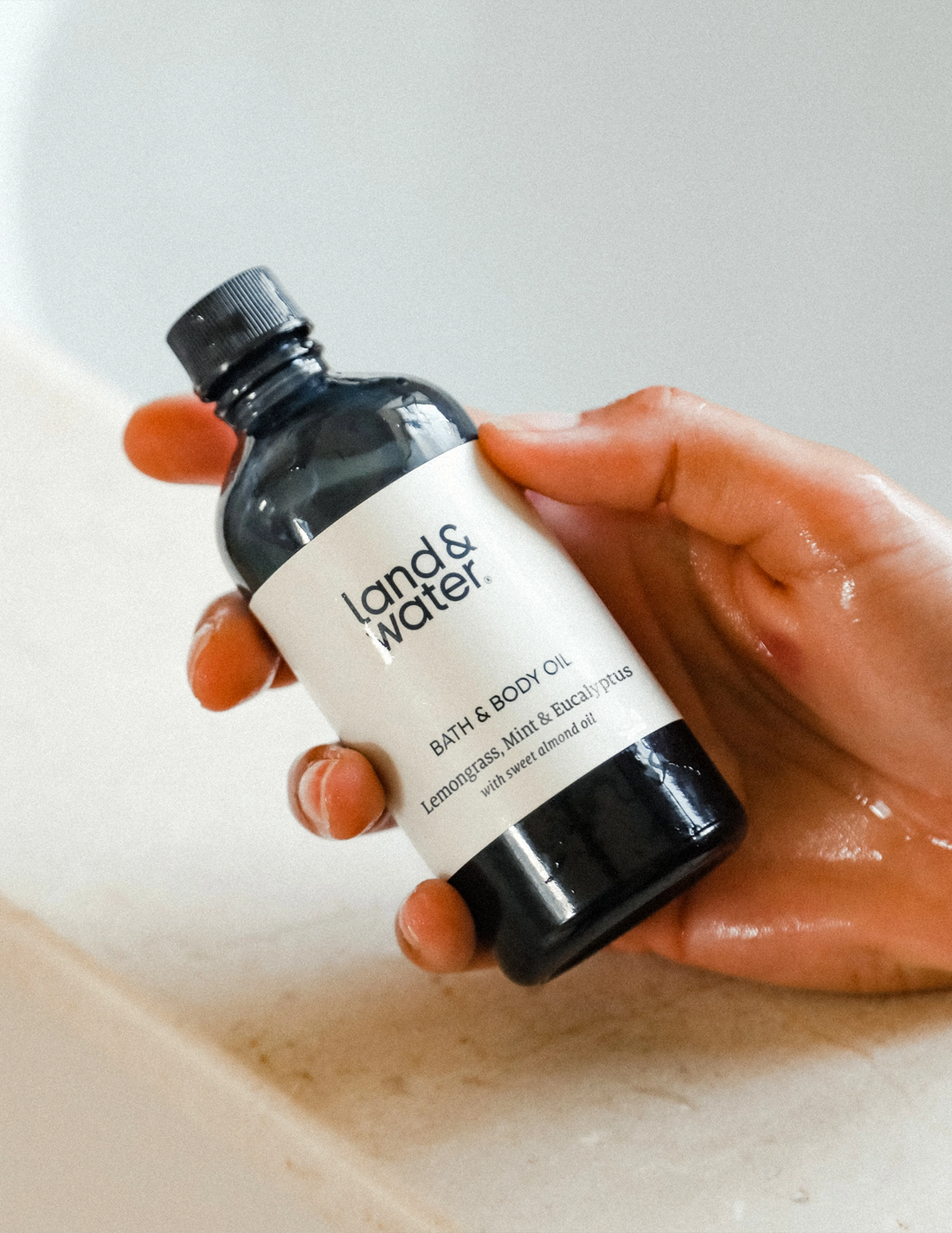Rosehip. Samphire. Aloe vera. Blackberry. Sea buckthorn. Spike moss. Travelling from shoreline to treetops, autumn harvest to summer hedgerow, our skincare recipes harness powerful natural actives to give a fresh-faced glow and evoke that radiance after time outside.
Moisture-locking and anti-oxidant, regenerating and smoothing, discover the science, history and folklore behind these transformative land&water ingredients, from flower oils to fruit extracts.
BLACKBERRY OIL

Bringing the brightness of shoreline hedgerows to our skincare recipes, blackberries sprout in glossy purple-black clusters from late summer, staining greedy hands and sweetening foraged suppers.
Packed with skin-enhancing vitamins C, A and E, these juicy black knots have significant antioxidant activity – helping to slow signs of ageing, target acne and stimulate collagen production.
Blackberries have thrived in the wild for thousands of years, with gathered blackberries discovered at Neolithic sites and even in the stomach of a preserved Iron Age woman.
Best picked before autumn rains have dulled their shine, folklore declares them inedible after Michaelmas (September 29). The story goes that when the devil was banished from heaven by St Michael, he landed in hell on a thorny blackberry bush, cursing its fruit in his fury – and making it unfit to eat after that day. Greek mythology attributes blackberries to the blood of the Titans, spilled in battle with the Olympian gods, while passing through the arch of a bramble was believed by the Celts to have special powers, from protection against evil spirits to curing sickness.
HYALURONIC ACID
 While the word ‘acid’ might seem alarming at first glance, hyaluronic acid is a wholly benign ingredient that rehydrates and rejuvenates the skin.
While the word ‘acid’ might seem alarming at first glance, hyaluronic acid is a wholly benign ingredient that rehydrates and rejuvenates the skin.
Hyaluronic acid occurs naturally in the body, lubricating joints, cushioning the eyes and protecting tissues from damage. And yet age and environmental aggressors weaken its natural moisture-retaining powers, which is where topical application comes in.
Able to hold more than 1,000 times its weight in water, hyaluronic acid is an essential hydrating ingredient in our facial moisturisers. Effectively fighting signs of ageing, hyaluronic acid boosts elasticity and plumpness, fills fine lines, reduces deep wrinkles, smoothes crow’s feet, and is suitable for all skin types.
VITAMIN C

A key ingredient in our skin-brightening recipes and a powerful antioxidant, vitamin C has the science to back up the beauty industry buzz. Proven to protect against pollution and UV-induced oxidative damage, vitamin C is the outdoor-lover’s best friend, helping to reduce dark spots and hyperpigmentation.
Vitamin C (AKA ascorbic acid) is also essential for a spectrum of bodily functions beyond the skin, from cell protection to wound healing, iron absorption and – perhaps most famously – immune system support. Colorful fruit and veg – kiwis, kale, oranges, broccoli, berries – are delicious natural sources, but vitamin C-enhanced skincare offers an easy topical option for enhancing your complexion.
Renowned for brightening dull skin and giving it a glow, vitamin C stimulates collagen production. Not only that, it also tackles fine lines, wrinkles and acne, and firms up the skin for a fresh-faced radiance.
ROSEHIP OIL

Rosehips – the nutrient-packed seed pods of rose plants – cheer up autumnal landscapes with their vibrant orangey-red hue. Usually oval-shaped and waxy in texture, these compact hips are popular with wild food foragers.
Abundant in antioxidants and essential fatty acids, rosehips can help ease arthritis, reduce blood pressure, strengthen immunity, and promote healthy skin. They’re also incredibly rich in vitamin C, containing up to 20 times more than oranges. With immunity-boosting citrus fruits scarce during World War II, the Ministry of Food published recipes for rosehip syrup, and hip-harvesting volunteers scoured the countryside.
In folklore, rosehips often symbolise love and good luck. In some traditions, the 100-day maturity period of rosehips represents waiting patiently for your true love, with rosehips placed in a handkerchief and tied with a red ribbon as part of a wish for romance.
We select rosehip oil for our skincare recipes for its unique ability to regenerate, hydrate, and brighten the skin. Deeply moisturising, rosehip oil visibly smooths the skin, leaving a lit-from-within glow.
SWEET ALMOND OIL

Rich in vitamins like A, B and E, sweet almond oil softens, calms and protects against skin irritation.
Deeply moisturising and nourishing thanks to its essential fatty acids, sweet almond oil retains a lightweight, non-comedogenic texture – meaning it won’t clog pores and doesn’t feel greasy.
Its soothing, cell-regenerating properties help reduce the appearance of dark spots and hyperpigmentation, protect skin from UV radiation damage, and keep it smooth and line-free.
ALOE VERA

Snap off the tip of the aloe vera plant’s thick, spiny leaves, and a clear gel oozes out. Brimming with amino acids, minerals and vitamins A, C, E and B12, this miraculous substance has been used for millennia for its medicinal and beauty-enhancing properties – and lends land&water skincare recipes plenty of plant power.
Happiest in hot, dry climates, aloe vera was dubbed ‘the plant of immortality’ by the ancient Egyptians and the ‘silent healer’ by Hindus. Egyptian queens Nefertiti and Cleopatra reportedly included it in their beauty regimes, while Alexander the Great used it to treat soldiers’ wounds. Today, this lush green plant’s potential shines through in skincare, healing burns, soothing abrasions, and offering intense hydration.
By locking in moisture, aloe vera delivers a softer, smoother complexion and supports a healthy skin barrier. Aloe stimulates collagen production and elastin fibres, making the skin plumper and less wrinkled. The high vitamin content guards against free radical damage, while the antibacterial qualities of aloe vera can also help prevent acne.
POMEGRANATE

Regal and jewel-like, the pomegranate is packed with inflammation-fighting and cell-protecting antioxidants. Rich in polyphenols, vitamin C and folic acid, it has long featured in remedies for digestive and skin disorders, and, according to research, could help prevent disease.
It’s also a plant laden with symbolism and myth. With a Latin name, Malum granatum, meaning ‘grainy apple’, ancient Iranian Christianity says the pomegranate was the real forbidden fruit of the Garden of Eden.
A glowing orb of vibrant ruby-orange, the pomegranate is often portrayed as a symbol of fertility and abundance. Greek mythology associates it with Aphrodite, the goddess of love, and Hera, the goddess of marriage and childbirth. Newlywed Roman women wore crowns of pomegranate leaves and drank the juice to treat infertility. The fruit also famously featured in the Greek myth of Hades and Persephone, with Hades, god of the underworld, luring Persephone below ground using pomegranate seeds.
Blended in our skincare treatments, pomegranate extract locks in moisture and helps to repair skin, nourishing deeply, targeting signs of ageing and improving elasticity.
VITAMIN E

Bolstering the skin barrier, soothing the complexion and reducing the appearance of scars: vitamin E is a skin-nourishing super ingredient.
While we use vitamin E for its potent antioxidant properties and hydrating power, it’s also vital for various bodily functions, from maintaining healthy eyes to promoting red blood cell formation and strengthening our natural defence against infection. Found in nuts, seeds, plant oils and leafy greens, vitamin E also plays a crucial role in protecting cells from damage caused by free radicals.
CALENDULA

Prized for its healing properties, the golden-orange calendula flower is a cottage (and medicinal) garden favourite.
Bursting with active compounds, this cheerful plant works to combat inflammation, promote tissue growth, and strengthen the skin barrier. We harness it in our recipes to de-stress and restore sensitive or imbalanced skin, but the calendula flower is also rich in symbolism and cultural significance.
To the Victorians, the calendula, or marigold, represented remembrance and mourning. In India, purportedly protective marigolds are strung into garlands for weddings and religious rituals. On Midsummer’s Eve, when the natural world was said to have magical powers, the calendula was picked for its enhanced healing abilities, while strewing it under your bed was thought to offer protection from thieves. The highly pigmented calendula flower is also used to dye foods, fabrics and cosmetics a sunny gold.
Explore our new skincare collection









